Attractions · Europe · Food and Drink · Going Out · Malta · Regions · Travel Miscellany · Western Europe
9 reasons to visit Valletta, European Capital of Culture, in 2018
Malta’s tiny capital, Europe’s smallest, takes you back to the 1570s. Built on a rocky peninsula – as the ultimate bastion-and-fire-power defence against a Turkish empire rampaging through the Mediterranean – Valletta was the first planned city in Europe.
 European Capital of Culture
2018, with hundreds of cultural events planned, is the best of times to visit Valletta. As ever there are 350 historic sites crammed into a site that UNESCO recognises as “one of the most concentrated historic areas in the world.”
European Capital of Culture
2018, with hundreds of cultural events planned, is the best of times to visit Valletta. As ever there are 350 historic sites crammed into a site that UNESCO recognises as “one of the most concentrated historic areas in the world.”
 But this year, funded by a €10m grant, there will be around 1,000 local and international artists, curators, performers, workshop leaders, writers, designers, choirs and film-makers making it a very lively cultural time in Valletta. There is a strong participatory theme to the programme: with invitations to the public to act, blog, create, design and sing.
A slice of Renaissance architecture
Valletta, Renaissance-style high-rise, is a city designed for walking. Even though it was built to a grid-plan, narrow passageways and steep streets of steps make it impossible for cars to access much of this compact city. So, the scirocco, a hot wind blowing in from North Africa, whips through the narrow alleys, still cleansing as it was intended to five centuries ago.
But this year, funded by a €10m grant, there will be around 1,000 local and international artists, curators, performers, workshop leaders, writers, designers, choirs and film-makers making it a very lively cultural time in Valletta. There is a strong participatory theme to the programme: with invitations to the public to act, blog, create, design and sing.
A slice of Renaissance architecture
Valletta, Renaissance-style high-rise, is a city designed for walking. Even though it was built to a grid-plan, narrow passageways and steep streets of steps make it impossible for cars to access much of this compact city. So, the scirocco, a hot wind blowing in from North Africa, whips through the narrow alleys, still cleansing as it was intended to five centuries ago.
 Even intense bombing during the Second World War failed to destroy Valletta’s charm and character. Families, making up Valletta’s population of just 7,000, still live behind the geranium filled window boxes and colourful wooden shutters, children still play football on cobbles which become more uneven for every generation.
Triq-ir-Republikka
The Main Street which runs 1.5 km from the massively imposing city gates through to St Elmo’s fort is at its best in the morning. Before lunchtime there’s a buzz to the boutiques, cafes and historic piazzas.
Even intense bombing during the Second World War failed to destroy Valletta’s charm and character. Families, making up Valletta’s population of just 7,000, still live behind the geranium filled window boxes and colourful wooden shutters, children still play football on cobbles which become more uneven for every generation.
Triq-ir-Republikka
The Main Street which runs 1.5 km from the massively imposing city gates through to St Elmo’s fort is at its best in the morning. Before lunchtime there’s a buzz to the boutiques, cafes and historic piazzas.
 After lunch, when many of the market stalls have packed away for the day, the traditional spirit of the siesta, once considered essential in the baking heat of summer, lazily lingers on.
Grand Harbour views
A deep natural harbour at the heart of the Mediterranean, Valletta has been strategically significant for millennia. Best to begin your exploration by looking down on strata after strata of history from Upper Barracca Gardens.
After lunch, when many of the market stalls have packed away for the day, the traditional spirit of the siesta, once considered essential in the baking heat of summer, lazily lingers on.
Grand Harbour views
A deep natural harbour at the heart of the Mediterranean, Valletta has been strategically significant for millennia. Best to begin your exploration by looking down on strata after strata of history from Upper Barracca Gardens.
 Even with all the cranes and contemporary heavy industry crowding the shoreline, in luminous summer there are enough Baroque remnants to give a sense of a Canaletto-style waterscape.
At sea level, on a calm day, a half-hour tour on a traditional wooden dghajsa, with the oarsmen standing up, is the best way to get a sense of the immensity of this harbour. On land the red post boxes are a reminder of how important Malta was to the British Empire in the first half of the 20th Century.
The Lascaris War Rooms
The cliff top bastion, named after a former Grandmaster, sits above the war rooms which were laboriously and urgently excavated during the punishing bombardment of Malta’s docks during the Second World War.
Descend into the tunnels, once the slave accommodation of the order of St John, which served as Headquarters for the defence of Malta against German and Italian attacks. In the early years of the war, in the Operations Room of maps and plotting tables, there was just one telephone to co-ordinate the launching of fighter planes as they fought off wave after wave of attacks. So heavy were aircraft losses that ships were positioned to scoop up surviving pilots as soon as they ejected from their burning aircraft.
Even with all the cranes and contemporary heavy industry crowding the shoreline, in luminous summer there are enough Baroque remnants to give a sense of a Canaletto-style waterscape.
At sea level, on a calm day, a half-hour tour on a traditional wooden dghajsa, with the oarsmen standing up, is the best way to get a sense of the immensity of this harbour. On land the red post boxes are a reminder of how important Malta was to the British Empire in the first half of the 20th Century.
The Lascaris War Rooms
The cliff top bastion, named after a former Grandmaster, sits above the war rooms which were laboriously and urgently excavated during the punishing bombardment of Malta’s docks during the Second World War.
Descend into the tunnels, once the slave accommodation of the order of St John, which served as Headquarters for the defence of Malta against German and Italian attacks. In the early years of the war, in the Operations Room of maps and plotting tables, there was just one telephone to co-ordinate the launching of fighter planes as they fought off wave after wave of attacks. So heavy were aircraft losses that ships were positioned to scoop up surviving pilots as soon as they ejected from their burning aircraft.
 Newsreel film shows how the remains of a British convoy limped into Valletta to provide desperately needed supplies. For their bravery, the people of Malta were awarded the Military Cross.
Then in 1943, General Eisenhower used the same Operations Room to control Operation Husky, the Allied Invasion of Scilly.
Grand Master’s Palace
Since 1571, when Valletta took over from inland Mdina, as Malta’s Capital, the intensely ornate Grand Palace has been the showy seat of power in Malta. Throughout the 18th Century, before Napoleon deposed the Knights of St John, a succession of Grand Masters collected tapestries, portraits and luxurious artefacts.
Newsreel film shows how the remains of a British convoy limped into Valletta to provide desperately needed supplies. For their bravery, the people of Malta were awarded the Military Cross.
Then in 1943, General Eisenhower used the same Operations Room to control Operation Husky, the Allied Invasion of Scilly.
Grand Master’s Palace
Since 1571, when Valletta took over from inland Mdina, as Malta’s Capital, the intensely ornate Grand Palace has been the showy seat of power in Malta. Throughout the 18th Century, before Napoleon deposed the Knights of St John, a succession of Grand Masters collected tapestries, portraits and luxurious artefacts.
 Although Parliament recently moved to new premises the President remains in the Palace. Occasionally the State Rooms are closed to the Public for official functions but the Knights Armoury remains open
Manoel Theatre
This ornate theatre’s programme is a cultural magnet not just for the Maltese. For folks on the neighbouring island of Gozo a night-out can be a ferry to Valletta for a concert, play or opera before catching a late ferry home.
Originally commissioned by the Knights of St John in 1731, the golden interior of the theatre, with one massive central chandelier, has the extravagant elegance of a bygone era.
Although Parliament recently moved to new premises the President remains in the Palace. Occasionally the State Rooms are closed to the Public for official functions but the Knights Armoury remains open
Manoel Theatre
This ornate theatre’s programme is a cultural magnet not just for the Maltese. For folks on the neighbouring island of Gozo a night-out can be a ferry to Valletta for a concert, play or opera before catching a late ferry home.
Originally commissioned by the Knights of St John in 1731, the golden interior of the theatre, with one massive central chandelier, has the extravagant elegance of a bygone era.
 Although the theatre was beautifully restored in 1960 there is little space to spare. At the interval theatre-goers, often in black-tie or evening gowns, enjoy their drinks in neighbouring bars and cafes. This Spring audiences will take a break from Opera Week and The Crucible to catch up on football scores from the matches showing on the bars’ televisions.
St John’s Co-Cathedral
Designed by the same military architects who built the citadel capital in the 1570s, the exterior of the cathedral is deceptively functional and plain. In contrast the gold, marble and vibrant colours covering every last inch of the interior can overwhelm the senses.
This is competitive holier-than-thou-worship at its best or worst. Each language group of the Knights of St John had their own chapel area within Malta’s primary place of worship. Inevitably each group competed to see who could produce the most elaborate and sumptuous decor for their chapel. As every Knight, on promotion to the order, was required to make a gift, the Cathedral became crammed with artefacts.
Although the theatre was beautifully restored in 1960 there is little space to spare. At the interval theatre-goers, often in black-tie or evening gowns, enjoy their drinks in neighbouring bars and cafes. This Spring audiences will take a break from Opera Week and The Crucible to catch up on football scores from the matches showing on the bars’ televisions.
St John’s Co-Cathedral
Designed by the same military architects who built the citadel capital in the 1570s, the exterior of the cathedral is deceptively functional and plain. In contrast the gold, marble and vibrant colours covering every last inch of the interior can overwhelm the senses.
This is competitive holier-than-thou-worship at its best or worst. Each language group of the Knights of St John had their own chapel area within Malta’s primary place of worship. Inevitably each group competed to see who could produce the most elaborate and sumptuous decor for their chapel. As every Knight, on promotion to the order, was required to make a gift, the Cathedral became crammed with artefacts.
 Even though there is an audio guide it is worth undertaking some research in advance to ensure that you do not miss highlights such as Caravaggio’s “Beheading of St John.”
If your Latin is up to the challenge, there are High Mass Services on Sundays and Festival Days.
Dining
Long ago Maltese food threw off the restricting shackles of the British empire and bland Shepherd’s Pie cuisine – even though Valletta still has its own Marks and Spencer store.
Valletta has dozens of restaurants where you can dine out on a piazza or the waterfront or on one of the narrow streets where a handful of tables are set.
Even though there is an audio guide it is worth undertaking some research in advance to ensure that you do not miss highlights such as Caravaggio’s “Beheading of St John.”
If your Latin is up to the challenge, there are High Mass Services on Sundays and Festival Days.
Dining
Long ago Maltese food threw off the restricting shackles of the British empire and bland Shepherd’s Pie cuisine – even though Valletta still has its own Marks and Spencer store.
Valletta has dozens of restaurants where you can dine out on a piazza or the waterfront or on one of the narrow streets where a handful of tables are set.
 Of course, for an island in the middle of the Mediterranean, the sea-food is outstanding. With Italy as a near neighbour there’s a strong Italian influence of pasta and pizza, though locally sourced rabbit casserole is a favourite too.
Of course, for an island in the middle of the Mediterranean, the sea-food is outstanding. With Italy as a near neighbour there’s a strong Italian influence of pasta and pizza, though locally sourced rabbit casserole is a favourite too.
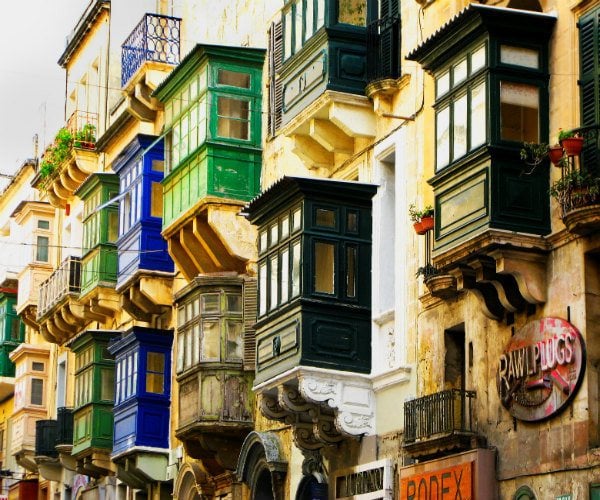 European Capital of Culture
2018, with hundreds of cultural events planned, is the best of times to visit Valletta. As ever there are 350 historic sites crammed into a site that UNESCO recognises as “one of the most concentrated historic areas in the world.”
European Capital of Culture
2018, with hundreds of cultural events planned, is the best of times to visit Valletta. As ever there are 350 historic sites crammed into a site that UNESCO recognises as “one of the most concentrated historic areas in the world.”
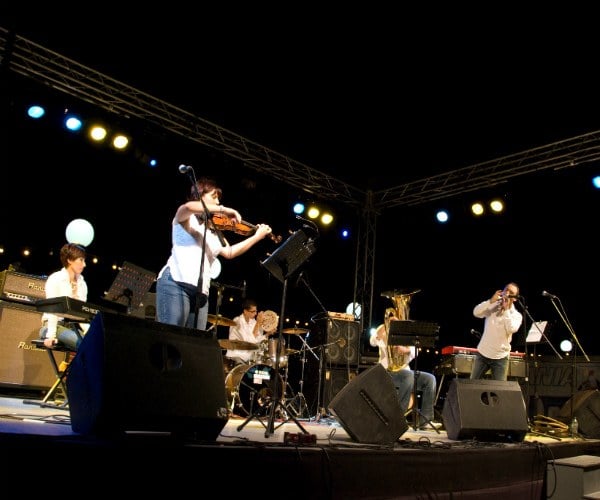 But this year, funded by a €10m grant, there will be around 1,000 local and international artists, curators, performers, workshop leaders, writers, designers, choirs and film-makers making it a very lively cultural time in Valletta. There is a strong participatory theme to the programme: with invitations to the public to act, blog, create, design and sing.
A slice of Renaissance architecture
Valletta, Renaissance-style high-rise, is a city designed for walking. Even though it was built to a grid-plan, narrow passageways and steep streets of steps make it impossible for cars to access much of this compact city. So, the scirocco, a hot wind blowing in from North Africa, whips through the narrow alleys, still cleansing as it was intended to five centuries ago.
But this year, funded by a €10m grant, there will be around 1,000 local and international artists, curators, performers, workshop leaders, writers, designers, choirs and film-makers making it a very lively cultural time in Valletta. There is a strong participatory theme to the programme: with invitations to the public to act, blog, create, design and sing.
A slice of Renaissance architecture
Valletta, Renaissance-style high-rise, is a city designed for walking. Even though it was built to a grid-plan, narrow passageways and steep streets of steps make it impossible for cars to access much of this compact city. So, the scirocco, a hot wind blowing in from North Africa, whips through the narrow alleys, still cleansing as it was intended to five centuries ago.
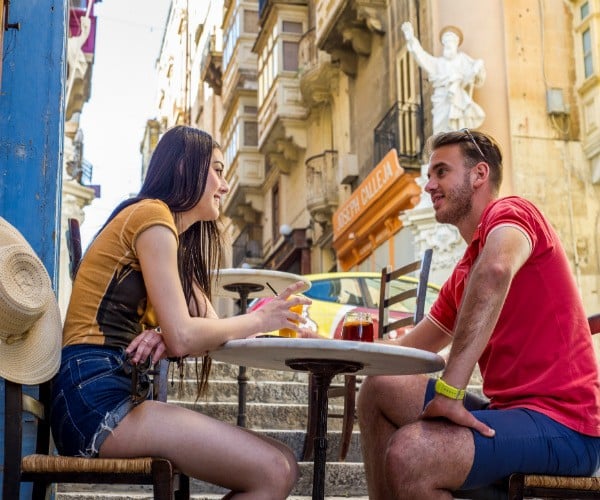 Even intense bombing during the Second World War failed to destroy Valletta’s charm and character. Families, making up Valletta’s population of just 7,000, still live behind the geranium filled window boxes and colourful wooden shutters, children still play football on cobbles which become more uneven for every generation.
Triq-ir-Republikka
The Main Street which runs 1.5 km from the massively imposing city gates through to St Elmo’s fort is at its best in the morning. Before lunchtime there’s a buzz to the boutiques, cafes and historic piazzas.
Even intense bombing during the Second World War failed to destroy Valletta’s charm and character. Families, making up Valletta’s population of just 7,000, still live behind the geranium filled window boxes and colourful wooden shutters, children still play football on cobbles which become more uneven for every generation.
Triq-ir-Republikka
The Main Street which runs 1.5 km from the massively imposing city gates through to St Elmo’s fort is at its best in the morning. Before lunchtime there’s a buzz to the boutiques, cafes and historic piazzas.
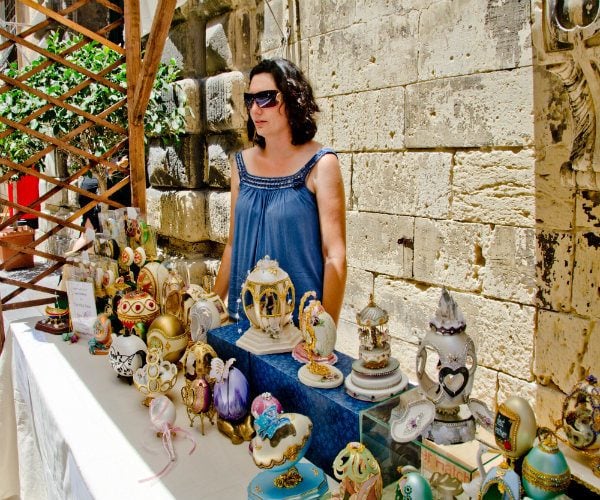 After lunch, when many of the market stalls have packed away for the day, the traditional spirit of the siesta, once considered essential in the baking heat of summer, lazily lingers on.
Grand Harbour views
A deep natural harbour at the heart of the Mediterranean, Valletta has been strategically significant for millennia. Best to begin your exploration by looking down on strata after strata of history from Upper Barracca Gardens.
After lunch, when many of the market stalls have packed away for the day, the traditional spirit of the siesta, once considered essential in the baking heat of summer, lazily lingers on.
Grand Harbour views
A deep natural harbour at the heart of the Mediterranean, Valletta has been strategically significant for millennia. Best to begin your exploration by looking down on strata after strata of history from Upper Barracca Gardens.
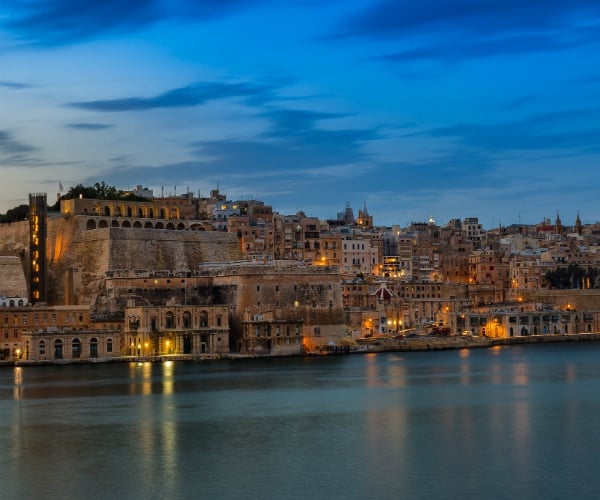 Even with all the cranes and contemporary heavy industry crowding the shoreline, in luminous summer there are enough Baroque remnants to give a sense of a Canaletto-style waterscape.
At sea level, on a calm day, a half-hour tour on a traditional wooden dghajsa, with the oarsmen standing up, is the best way to get a sense of the immensity of this harbour. On land the red post boxes are a reminder of how important Malta was to the British Empire in the first half of the 20th Century.
The Lascaris War Rooms
The cliff top bastion, named after a former Grandmaster, sits above the war rooms which were laboriously and urgently excavated during the punishing bombardment of Malta’s docks during the Second World War.
Descend into the tunnels, once the slave accommodation of the order of St John, which served as Headquarters for the defence of Malta against German and Italian attacks. In the early years of the war, in the Operations Room of maps and plotting tables, there was just one telephone to co-ordinate the launching of fighter planes as they fought off wave after wave of attacks. So heavy were aircraft losses that ships were positioned to scoop up surviving pilots as soon as they ejected from their burning aircraft.
Even with all the cranes and contemporary heavy industry crowding the shoreline, in luminous summer there are enough Baroque remnants to give a sense of a Canaletto-style waterscape.
At sea level, on a calm day, a half-hour tour on a traditional wooden dghajsa, with the oarsmen standing up, is the best way to get a sense of the immensity of this harbour. On land the red post boxes are a reminder of how important Malta was to the British Empire in the first half of the 20th Century.
The Lascaris War Rooms
The cliff top bastion, named after a former Grandmaster, sits above the war rooms which were laboriously and urgently excavated during the punishing bombardment of Malta’s docks during the Second World War.
Descend into the tunnels, once the slave accommodation of the order of St John, which served as Headquarters for the defence of Malta against German and Italian attacks. In the early years of the war, in the Operations Room of maps and plotting tables, there was just one telephone to co-ordinate the launching of fighter planes as they fought off wave after wave of attacks. So heavy were aircraft losses that ships were positioned to scoop up surviving pilots as soon as they ejected from their burning aircraft.
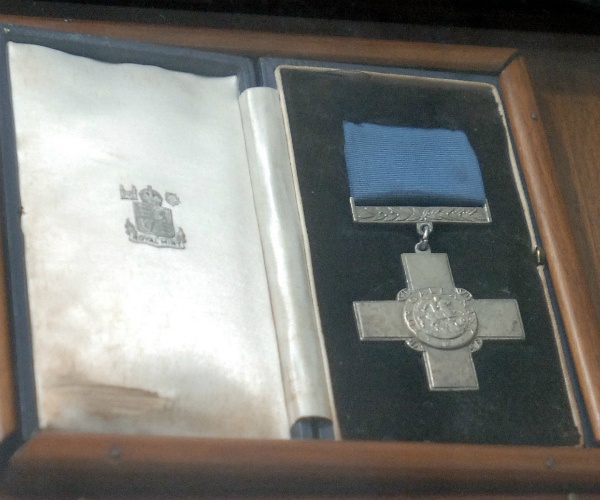 Newsreel film shows how the remains of a British convoy limped into Valletta to provide desperately needed supplies. For their bravery, the people of Malta were awarded the Military Cross.
Then in 1943, General Eisenhower used the same Operations Room to control Operation Husky, the Allied Invasion of Scilly.
Grand Master’s Palace
Since 1571, when Valletta took over from inland Mdina, as Malta’s Capital, the intensely ornate Grand Palace has been the showy seat of power in Malta. Throughout the 18th Century, before Napoleon deposed the Knights of St John, a succession of Grand Masters collected tapestries, portraits and luxurious artefacts.
Newsreel film shows how the remains of a British convoy limped into Valletta to provide desperately needed supplies. For their bravery, the people of Malta were awarded the Military Cross.
Then in 1943, General Eisenhower used the same Operations Room to control Operation Husky, the Allied Invasion of Scilly.
Grand Master’s Palace
Since 1571, when Valletta took over from inland Mdina, as Malta’s Capital, the intensely ornate Grand Palace has been the showy seat of power in Malta. Throughout the 18th Century, before Napoleon deposed the Knights of St John, a succession of Grand Masters collected tapestries, portraits and luxurious artefacts.
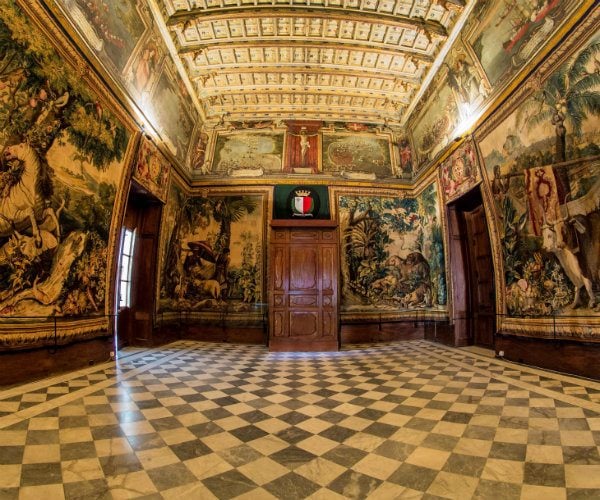 Although Parliament recently moved to new premises the President remains in the Palace. Occasionally the State Rooms are closed to the Public for official functions but the Knights Armoury remains open
Manoel Theatre
This ornate theatre’s programme is a cultural magnet not just for the Maltese. For folks on the neighbouring island of Gozo a night-out can be a ferry to Valletta for a concert, play or opera before catching a late ferry home.
Originally commissioned by the Knights of St John in 1731, the golden interior of the theatre, with one massive central chandelier, has the extravagant elegance of a bygone era.
Although Parliament recently moved to new premises the President remains in the Palace. Occasionally the State Rooms are closed to the Public for official functions but the Knights Armoury remains open
Manoel Theatre
This ornate theatre’s programme is a cultural magnet not just for the Maltese. For folks on the neighbouring island of Gozo a night-out can be a ferry to Valletta for a concert, play or opera before catching a late ferry home.
Originally commissioned by the Knights of St John in 1731, the golden interior of the theatre, with one massive central chandelier, has the extravagant elegance of a bygone era.
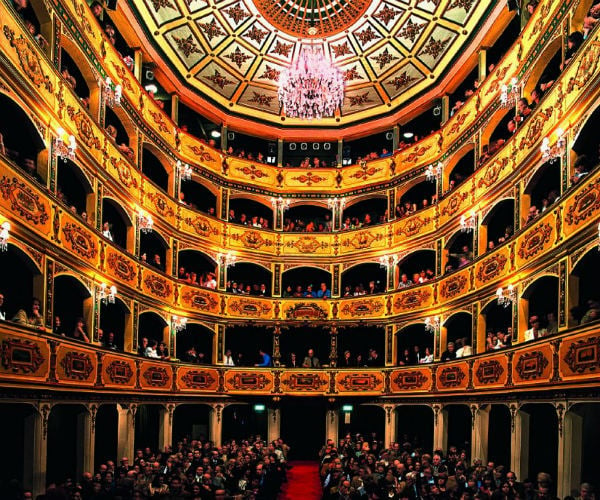 Although the theatre was beautifully restored in 1960 there is little space to spare. At the interval theatre-goers, often in black-tie or evening gowns, enjoy their drinks in neighbouring bars and cafes. This Spring audiences will take a break from Opera Week and The Crucible to catch up on football scores from the matches showing on the bars’ televisions.
St John’s Co-Cathedral
Designed by the same military architects who built the citadel capital in the 1570s, the exterior of the cathedral is deceptively functional and plain. In contrast the gold, marble and vibrant colours covering every last inch of the interior can overwhelm the senses.
This is competitive holier-than-thou-worship at its best or worst. Each language group of the Knights of St John had their own chapel area within Malta’s primary place of worship. Inevitably each group competed to see who could produce the most elaborate and sumptuous decor for their chapel. As every Knight, on promotion to the order, was required to make a gift, the Cathedral became crammed with artefacts.
Although the theatre was beautifully restored in 1960 there is little space to spare. At the interval theatre-goers, often in black-tie or evening gowns, enjoy their drinks in neighbouring bars and cafes. This Spring audiences will take a break from Opera Week and The Crucible to catch up on football scores from the matches showing on the bars’ televisions.
St John’s Co-Cathedral
Designed by the same military architects who built the citadel capital in the 1570s, the exterior of the cathedral is deceptively functional and plain. In contrast the gold, marble and vibrant colours covering every last inch of the interior can overwhelm the senses.
This is competitive holier-than-thou-worship at its best or worst. Each language group of the Knights of St John had their own chapel area within Malta’s primary place of worship. Inevitably each group competed to see who could produce the most elaborate and sumptuous decor for their chapel. As every Knight, on promotion to the order, was required to make a gift, the Cathedral became crammed with artefacts.
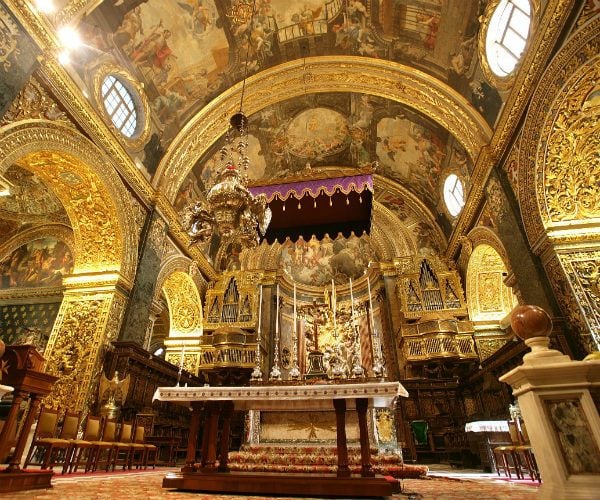 Even though there is an audio guide it is worth undertaking some research in advance to ensure that you do not miss highlights such as Caravaggio’s “Beheading of St John.”
If your Latin is up to the challenge, there are High Mass Services on Sundays and Festival Days.
Dining
Long ago Maltese food threw off the restricting shackles of the British empire and bland Shepherd’s Pie cuisine – even though Valletta still has its own Marks and Spencer store.
Valletta has dozens of restaurants where you can dine out on a piazza or the waterfront or on one of the narrow streets where a handful of tables are set.
Even though there is an audio guide it is worth undertaking some research in advance to ensure that you do not miss highlights such as Caravaggio’s “Beheading of St John.”
If your Latin is up to the challenge, there are High Mass Services on Sundays and Festival Days.
Dining
Long ago Maltese food threw off the restricting shackles of the British empire and bland Shepherd’s Pie cuisine – even though Valletta still has its own Marks and Spencer store.
Valletta has dozens of restaurants where you can dine out on a piazza or the waterfront or on one of the narrow streets where a handful of tables are set.
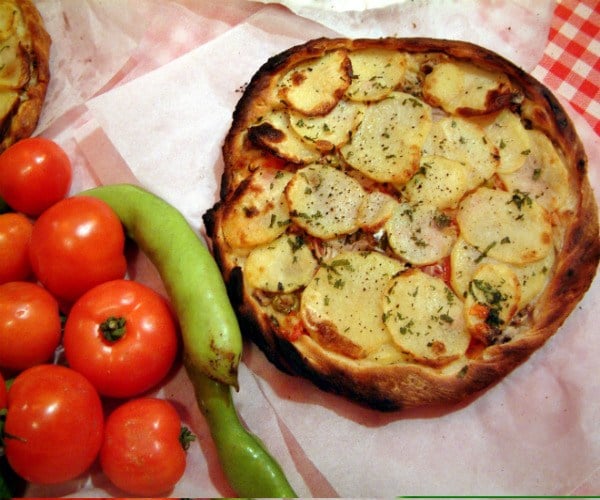 Of course, for an island in the middle of the Mediterranean, the sea-food is outstanding. With Italy as a near neighbour there’s a strong Italian influence of pasta and pizza, though locally sourced rabbit casserole is a favourite too.
Of course, for an island in the middle of the Mediterranean, the sea-food is outstanding. With Italy as a near neighbour there’s a strong Italian influence of pasta and pizza, though locally sourced rabbit casserole is a favourite too.Did you enjoy this article?
Receive similar content direct to your inbox.



I have visited Valletta last year, it was very particular: I was curious to see so many wooden colourful balconies, I enjoyed going through the narrow streets, it looked like being in the past. In my opinion
St John’s Co-Cathedral was the best thing. The fountain with tritons was out of order and I could not see it in action :(
I stayed five days in Valletta last year and really loved the history and feel of the city. Food was great, people friendly, bus and boat services help you get around island without a car. If you are thinking of a trip, then do it as you won’t be disappointed. I stayed near upper barracka gardens and walked everywhere, got the boats over to sliema and the three cities.